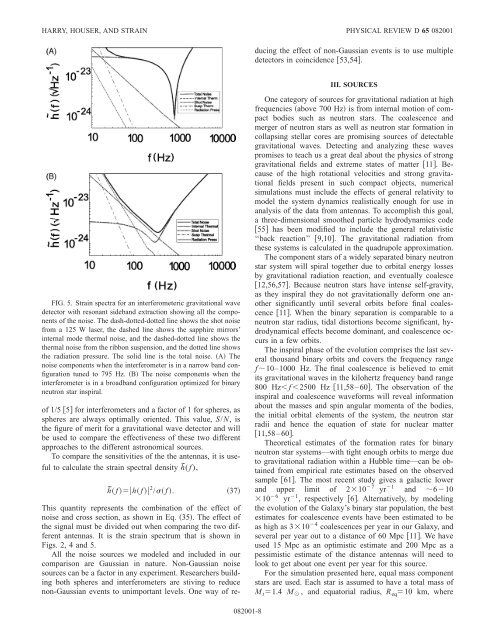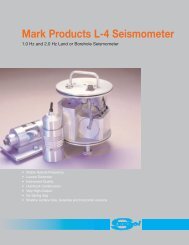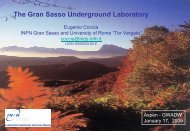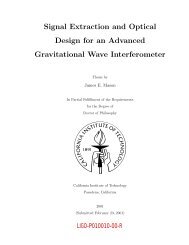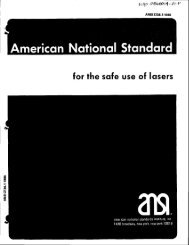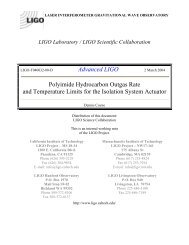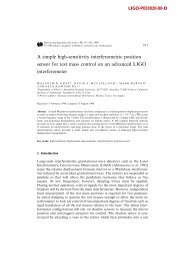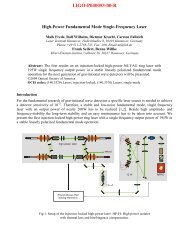LIGO-P030036-00-R - Ligo - Caltech
LIGO-P030036-00-R - Ligo - Caltech
LIGO-P030036-00-R - Ligo - Caltech
You also want an ePaper? Increase the reach of your titles
YUMPU automatically turns print PDFs into web optimized ePapers that Google loves.
HARRY, HOUSER, AND STRAIN PHYSICAL REVIEW D 65 082<strong>00</strong>1<br />
This quantity represents the combination of the effect of<br />
noise and cross section, as shown in Eq. 35. The effect of<br />
the signal must be divided out when comparing the two different<br />
antennas. It is the strain spectrum that is shown in<br />
Figs. 2, 4 and 5.<br />
All the noise sources we modeled and included in our<br />
comparison are Gaussian in nature. Non-Gaussian noise<br />
sources can be a factor in any experiment. Researchers building<br />
both spheres and interferometers are stiving to reduce<br />
non-Gaussian events to unimportant levels. One way of reducing<br />
the effect of non-Gaussian events is to use multiple<br />
detectors in coincidence 53,54.<br />
III. SOURCES<br />
FIG. 5. Strain spectra for an interferometeric gravitational wave<br />
detector with resonant sideband extraction showing all the components<br />
of the noise. The dash-dotted-dotted line shows the shot noise<br />
from a 125 W laser, the dashed line shows the sapphire mirrors’<br />
internal mode thermal noise, and the dashed-dotted line shows the<br />
thermal noise from the ribbon suspension, and the dotted line shows<br />
the radiation pressure. The solid line is the total noise. A The<br />
noise components when the interferometer is in a narrow band configuration<br />
tuned to 795 Hz. B The noise components when the<br />
interferometer is in a broadband configuration optimized for binary<br />
neutron star inspiral.<br />
of 1/5 5 for interferometers and a factor of 1 for spheres, as<br />
spheres are always optimally oriented. This value, S/N, is<br />
the figure of merit for a gravitational wave detector and will<br />
be used to compare the effectiveness of these two different<br />
approaches to the different astronomical sources.<br />
To compare the sensitivities of the the antennas, it is useful<br />
to calculate the strain spectral density h˜ ( f ),<br />
h˜ f h f 2 / f .<br />
37<br />
One category of sources for gravitational radiation at high<br />
frequencies above 7<strong>00</strong> Hz is from internal motion of compact<br />
bodies such as neutron stars. The coalescence and<br />
merger of neutron stars as well as neutron star formation in<br />
collapsing stellar cores are promising sources of detectable<br />
gravitational waves. Detecting and analyzing these waves<br />
promises to teach us a great deal about the physics of strong<br />
gravitational fields and extreme states of matter 11. Because<br />
of the high rotational velocities and strong gravitational<br />
fields present in such compact objects, numerical<br />
simulations must include the effects of general relativity to<br />
model the system dynamics realistically enough for use in<br />
analysis of the data from antennas. To accomplish this goal,<br />
a three-dimensional smoothed particle hydrodynamics code<br />
55 has been modified to include the general relativistic<br />
‘‘back reaction’’ 9,10. The gravitational radiation from<br />
these systems is calculated in the quadrupole approximation.<br />
The component stars of a widely separated binary neutron<br />
star system will spiral together due to orbital energy losses<br />
by gravitational radiation reaction, and eventually coalesce<br />
12,56,57. Because neutron stars have intense self-gravity,<br />
as they inspiral they do not gravitationally deform one another<br />
significantly until several orbits before final coalescence<br />
11. When the binary separation is comparable to a<br />
neutron star radius, tidal distortions become significant, hydrodynamical<br />
effects become dominant, and coalescence occurs<br />
in a few orbits.<br />
The inspiral phase of the evolution comprises the last several<br />
thousand binary orbits and covers the frequency range<br />
f 10–1<strong>00</strong>0 Hz. The final coalescence is believed to emit<br />
its gravitational waves in the kilohertz frequency band range<br />
8<strong>00</strong> Hz f 25<strong>00</strong> Hz 11,58–60. The observation of the<br />
inspiral and coalescence waveforms will reveal information<br />
about the masses and spin angular momenta of the bodies,<br />
the initial orbital elements of the system, the neutron star<br />
radii and hence the equation of state for nuclear matter<br />
11,58–60.<br />
Theoretical estimates of the formation rates for binary<br />
neutron star systems—with tight enough orbits to merge due<br />
to gravitational radiation within a Hubble time—can be obtained<br />
from empirical rate estimates based on the observed<br />
sample 61. The most recent study gives a galactic lower<br />
and upper limit of 210 7 yr 1 and 610<br />
10 6 yr 1 , respectively 6. Alternatively, by modeling<br />
the evolution of the Galaxy’s binary star population, the best<br />
estimates for coalescence events have been estimated to be<br />
as high as 310 4 coalescences per year in our Galaxy, and<br />
several per year out to a distance of 60 Mpc 11. We have<br />
used 15 Mpc as an optimistic estimate and 2<strong>00</strong> Mpc as a<br />
pessimistic estimate of the distance antennas will need to<br />
look to get about one event per year for this source.<br />
For the simulation presented here, equal mass component<br />
stars are used. Each star is assumed to have a total mass of<br />
M t 1.4 M , and equatorial radius, R eq 10 km, where<br />
082<strong>00</strong>1-8


